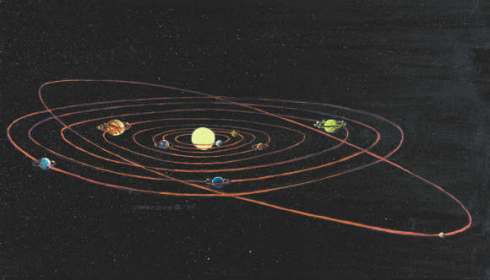 |
|
| Issue #66 • November/December, 2000 |
In a relatively short span of time, mankind has travelled from profound ignorance of our planet and the world in which we live to a rather detailed picture of not only our earth, but the solar system, the universe, and the forces that underlie the workings of most physical things. Not only do we have great understanding of the very large, such as clusters of galaxies on the fringes of the universe, but of the very small, such as quarks and gluons which comprise some of the subatomic particles and forces of nature.
Astoundingly, given the long amount of time we have inhabited this planet, most of this scientific knowledge has been acquired only within the last 400 years, ever since Galileo gazed upon the heavens through the newly invented telescope.
In fact, the two major pillars of science today, namely relativity and quantum mechanics, were discovered just within the last 100 years. And in only the last 20 years, scientists have been working to unravel the secrets of superstring theory, which may prove to be the final frontier in our quest to understand the ultimate laws of nature.

This astonishing science underlies our entire modern mechanical, electronics, and computer civilization. Without it we would be back to horse and buggy days, wringer washers, and the pony express. Of course for some of us, like those who relish a lifestyle truly primitive, that would be a nice turning back of the clock. But even they would take advantage of the remarkable advances in medicine that are part of this modern science, or occasionally use the telephone or their computer.
In this article I would like to go back a couple of thousand years to the Greeks who were among the first to propose scientific theories, and to travel forward in time on the backs of the great successful scientific theories that have advanced our knowledge and technology to where they are today. It is a fascinating tale of discovery, as strange as the science fiction stories it has often inspired. Even stranger are the new scientific theories of today, with their possibilities of time travel and their predictions of extra dimensions and parallel universes that may lie unseen just inches from our own.
I’ll break the scientific theories up into five historical segments beginning with Aristotle and the ancient Greeks, whose science dominated scientific thinking for more than a millennium. Then we’ll explore Copernican theory and Newton’s classical mechanics, which dominated science until about a hundred years ago. Finally we’ll visit the twin pillars of our modern science: relativity and quantum mechanics. We’ll end up by exploring a modern scientific theory that has some scientists buzzing with anticipation that they are onto something big, a theory that explains everythingsuperstring theory.
All are fascinating, and some, especially those that underlie the technology of our modern world, are downright bizarre.
A scientific theory is a working hypothesis
Before we examine the scientific theories, it’s important to understand just what a scientific theory is. It is simply a proposal of how the world might work. When referring to modern physics, English physicist Stephen Hawking has said that a scientific theory “is just a mathematical model we make to describe our observations: it exists only in our minds.” For simplicity of understanding, I will take a nonmathematical approach in explaining the theories.
What is important to understand about any scientific theory is that it is valid only until a better scientific theory comes along. The test of the validity of a scientific theory is that it must not only be able to explain present physical phenomena, but it must be able to make predictions of how future phenomena will behave. It is tested by physical experimentation, as in a laboratory, to determine if its predictions come true. No matter how many times experiment shows a theory to be a correct predictor, the next experiment may prove the theory wrong, thereby necessitating the need for a new theory or at least the modification of the current theory.
For example, when Isaac Newton proposed his theory of gravitation, the theory not only accounted for the orbit of the planets around the sun, which had already been theorized, but it allowed us, for the first time, to accurately predict the ocean tides, among many other things.
Newton’s theory of gravitation worked fine for more than 200 years, and even today we use it to help calculate the trajectories of rockets we send into outer space. But scientists knew the theory was slightly off because it didn’t accurately account for some things, such as the orbit of Mercury around the sun.

So in the early 1900s Albert Einstein proposed a new theory of gravitation, which was included in his general theory of relativity. Einstein’s theory was able to accurately calculate the orbit of Mercury, plus his theory made a great many predictions that were later experimentally shown to be accurate.
So you see, even though Newton’s theory was a bit off, it was still very useful to science for 200 years, and we still use it today.
The two major theories that underlie our modern world are relativity and quantum mechanics, which is the most successful theory in history. They contradict each other in certain respects, so we know there is a problem that must be resolved. One potential solution is a new theory called superstring theory, which holds the promise of unifying relativity and quantum mechanics into a “theory of everything.”
The point is that scientific theories can never be said to be true. They can only be said to be useful working hypotheses that we can use to explain physical phenomena and allow us to advance our technology.
Though Newton’s theory was slightly off, it still allows scientists, even today, to plot the orbits of the planets and comets, and to determine the masses of galaxies though they are millions of light years away. And even though Einstein’s theory may be slightly off, it still enables us to build nuclear power plants.
The great modern American scientist, Richard Feynman, who was the equal of Newton and Einstein in brilliance, equated scientific theories with educated guesses about how Nature works. He said science’s main utility was to allow us to guess a theory based on the success or failure of previous theories, make improvements in our technology, then guess an even better theory that allows us to improve even more.
Let’s go back about 2340 years and examine the first great scientific guess that became a scientific theory. It was by Aristotle, a Greek philosopher.
The first great theory: Aristotle and Ptolemy
In his work, On the Heavens, Aristotle proposed that terrestrial, or earthly, things were completely different than celestial, or heavenly, things. The natural state for celestial things was to be in motion, and the natural state for earthly things was to be at rest.
|
The earth was round and located at the center of the universe, and the fixed stars rotated about the earth on a celestial sphere that surrounded the earth.
Earthly things were made up of four basic elements: water, earth, fire, and air. Earth and water flowed toward their natural resting place at the center of the earth, with water resting on top of earth. Fire and air’s natural state was to rise toward the heavens.
In 150 AD, Ptolemy published his Almagest, which provided the mathematics to explain the motions of the wandering stars, which included the moon, sun, and the planets. Mathematics was to become the language of physics, and Ptolemy’s detailed calculations became part of Ptolemaic/Aristotelian theory.
In Ptolemy’s model the earth is a sphere, and the sun, moon, and planets are spheres that rotate in perfect circles around the earth. The Aristotelian idea that circular motion was perfection was to stay with science until the 16th century.
Although other ancient Greeks had suggested that the sun was really at the center of the earth, and that the earth rotated about it, the Aristotelian/Ptolemaic theory of the solar system came to be accepted and it held sway in science for about 1400 years.
The second great theory: the Copernican system
One of the problems with Ptolemy’s perfect spheres and circular motion was that he had to devise many deviations from the trigonometry he used to account for the unusual motions of the roving stars, which we now know are planets.
Many scientists realized something was wrong with the theory, and finally a Polish priest named Nicholas Copernicus revived the ancient Greek idea that placed the sun at the center of the universe and had the earth and planets rotating about it.

His work, On the Revolutions of the Celestial Orbs, was published in 1514. Although this was a significant step forward in science, its significance was not generally appreciated until the Italian astronomer, Galileo, looked through the newly invented telescope in 1609 and discovered the moons of Jupiter.
Jupiter and its moons looked like another solar system to Galileo, and he began to publicly support the idea that the earth and the other planets must rotate about the sun. As he was the greatest scientist of his day, his support for Copernican theory alarmed the Pope, whose Catholic Church supported Aristotelian theory. Galileo was summoned to Rome and ordered to recant, which he did. Galileo died several years later, still under house arrest because of his theory.
Nevertheless, Copernican theory gained support both within and without the scientific community. But great debates raged over exactly how the planets moved, so in the early 1600s, Tycho Brahe, a Dane, set up astronomical observing stations on an island he owned near Copenhagen and recorded the exact movements of the planets night after night.
The data collected was examined by the German mathematician Johannes Kepler, who deduced that the planets did not move in perfect circles, but in elongated circles called ellipses. Kepler’s laws of planetary motion showed how to calculate their movements precisely.
It was not only a great advance for science, but Brahe’s detailed observations showed that it was possible to test, verify, and refine a scientific theory by carefully observing the phenomena the theory predictsin this case the orbits of the planets about the sun.
The third great theory: Newton’s mechanics
The 1600s began an age of great scientific discovery. Frenchman Rene Descartes published his Principles of Philosophy, German Ole Roemer was able to determine a reasonably accurate speed of light, and a host of scientists in countries throughout Western Europe theorized and experimented in an effort to understand the laws of Natural Philosophy, which is what we now call science.
But it was not until 1687, when Englishman Sir Isaac Newton published his Mathematical Principle of Natural Philosophy, that a great and powerful new theory called classical mechanics, sometimes called Newton’s mechanics, was born.
Newton’s Principia (it was published in Latin) was probably the most important scientific work ever published, and it laid the foundation for modern science. In it he outlined his laws of motion and his theory of gravitation. Because an appropriate mathematics did not exist to explain his new laws, the brilliant Newton invented the calculus.

Newton not only explained how the planets orbited the sun in ellipses, but his universal law of gravitation gave precise calculations to show how every object attracts every other object: the force is proportional to their masses and inversely proportional to the square of the distance between them.
It was a universal law, Newton said, and it applied as equally to an object falling on earth as it did to a planet orbiting the sun. He said an object’s weight was a combination of its mass and the force of gravity.
His three laws of motion explained most known earthly and celestial motion:
- A body moves in a uniform motion, or remains at rest, unless a force acts upon it.
- The change of motion is proportional to and in the direction of the force acting upon it.
- For every action, there is an equal and opposite reaction.
Newton also essentially invented the science of optics. His early experiments with a prism showed how light, which he described as a stream of particles, could be divided into its various colors.
But it was Newton’s mechanics, plus his method of using experiment and observation to discover things, that would give rise to an unprecedented age of scientific discovery and invention during the 17th, 18th, and 19th centuries. Numerous laws, including those governing magnetism and electricity, were discovered, and they led to numerous inventions and technological improvements that brought on an increasingly sophisticated and technological era.

Ecclesiastical resistance to the new science not only lessened, but many scientists, who were often religious men, saw the new discoveries as an unfolding of God’s laws.
Newton himself was a deeply religious man, and he and many scientists who followed in his footsteps thought of themselves as helping to bring mankind closer to God by uncovering God’s laws embodied in Nature. Only much later was science divorced from religion and thought of as a totally separate pursuit.
The fourth great theory: Einstein’s relativity
Newton’s classical mechanics worked well until the latter part of the 19th century. But new discoveries of the laws that govern electromagnetic waves contradicted some of Newton’s laws. For example, in 1864 James Clerk Maxwell published his four Maxwell’s equations which showed that electromagnetic radiation travelled at a constant speed, which seemed to violate Newton’s law that speed had to be relative to something fixed. Maxwell realized that light was merely a form of electromagnetic wave. But, just as waves in water need water to travel through, and sound waves need air to travel through, for light to consist of waves it was thought there had to be a medium for them to travel through. So an ether was postulated that filled the universe so light could travel through space. The existence of this ether was necessary so Newton’s theory would not be violated.
But in 1887, in a famous experiment using light to measure the speed of the earth through the ether, it was discovered instead that the speed of light did indeed seem to be constant, regardless of the earth’s movement, in accordance with Maxwell’s equations.
Then in 1905 Einstein introduced his special theory of relativity, which dispensed with the idea of an ether and stated that the speed of light was constant at 186,000 miles per second (670 million miles per hour), and it did not have to be relative to anything.
Einstein’s theory also had some rather remarkable things to say:
- Nothing can go faster than the speed of light.
- Time slows down for anything approaching the speed of light.
- Each person has their own measure of time so that the same event can occur at different times for different observers.
- Mass and energy are equivalent. This is embodied in his famous equation, E= mc².

In 1915, Einstein followed up the special theory with his general theory of relativity. This addressed gravity and stated more startling things:
- Space and time are not separate entities but are combined in what he called space-time.
- Large objects, such as the earth and sun, warp space and time and are manifested as gravity.
If you are confused, so was the entire scientific community. Only a few scientists immediately caught on to the scientific revolution Einstein had wrought with his theories of relativity, but the theories would withstand the test of years of experiments. Newton’s classical mechanics had finally been overthrown.
One of the possibilities of Einstein’s relativity is time travel into a relativistic future. The laws of physics have shown that what is called the arrow of time can only go into the future, so travel backwards is impossible. But if one could devise a spaceship to travel at a significant fraction of the speed of light, one could travel into the future of those left behind.
The fifth great theory: quantum mechanics
The imprint of Einstein’s genius was not just his theories of relativity. He made significant contributions to quantum mechanics, which is the most successful scientific theory of all time.
Quantum mechanics governs, among other things, the behavior of integrated circuits, which are the key components of computers, and it underlies our ability to probe human DNA and control nuclear power. Not to mention that it allows us to have the lasers which operate CD players and the bar code readers in grocery stores.
It was Max Planck who, in 1900, first suggested the idea of quanta emissions of energy in discrete packets. In 1905 Einstein said light consisted of particle-like quanta, even though most scientists considered light to consist of waves, not particles.
 This is the map of the solar system today. It is not to scale; for example, Pluto, the outermost planet, would be much further out from the sun. We now know that our sun is only one of about one hundred billion stars in our galaxy, the Milky Way. The Milky Way, which is a hundred thousand light years across, is one of about one hundred billion galaxies we can see with modern telescopes. |
Quantum mechanics is a theory that says energy is emitted or absorbed only in discrete packets called quanta. The quanta can travel from point A to point B by any of an infinite number of routes, each route being determined by a mathematical probability associated with the route. We now know the energy associated with quanta acts both like a wave and a particle.
One of the key elements of quantum mechanics is the uncertainty principle, which states that either a particle’s position or velocity can be measured precisely, but not both. In a nutshell, quantum mechanics states that nothing can ever be known for sure because you can only have a certain probability that a specific event will occur, and that matter, in its most basic form, behaves in a way that is inexplicable.
Confused? The great American physicist Richard Feynman once said, “I think I can safely say that nobody understands quantum mechanics.”

The present theory of quantum mechanics was developed in the 1920s by Werner Heisenberg, Erwin Schrodinger, and Paul Dirac. Richard Feynman reformulated it in the 1940s to make it easier to work with and to make it compatible with relativity.
But relativity and quantum mechanics are still not completely compatible. Where relativity describes the world of the very large, such as stars and galaxies, quantum mechanics describes the world of particles as small or smaller than atoms, but it describes it more precisely than any theory in history, in spite of the uncertainty inherent in the theory. It seems to be the basic nature of things to be uncertain at the atomic and subatomic level.
The next great theory: superstring theory
As you can see, the closer we get to modern times the more unintuitive scientific theories become. No more clear and simple ideas of planets orbiting stars; modern theories are simply strange, and superstring theory is as strange as they come.
Superstring theory is the latest guess, if we can use Richard Feynman’s terminology. It is a mathematical guess at how relativity and quantum mechanics can be unified into one grand “theory of everything.”
The diagram on this page gives the present scientific view of matter’s tiniest components, with the vibrating strings being what superstring theory says are the tiniest components.
Superstring theory is only a mathematical description at present. It makes no predictions about how phenomena will behave, as all the previous theories did. Mathematically, it works not in the four dimensions we are used to (3 space and 1 time), but in either 10 or 26 dimensions. And it suggests the possibility of shadow, or alternate, universes. Did I mention bizarre?
 Current theory: quarks and electrons are the smallest particles of matter, but superstring theory says these may be actually vibrating strings. |
The extra dimensions may be curled up in the space-time of the subatomic world, but they do not seem to be available to humans. But as a mathematical description of the universe, some scientists think superstring theory may be on the verge of unifying relativity and quantum mechanics and so unify all the particles and forces of Nature.
If all this sounds a bit preposterous, it is simply because you are not used to thinking the way modern scientists must think to comprehend these complex, but useful, theories.
Where are we now?
So what is the status of our scientific knowledge and theories today? We have come a long way from Aristotle and Ptolemy.
On the large scale, we know that our earth is one of nine planets that orbit an ordinary yellow star situated on an outer arm of a spiral galaxy that contains about one hundred billion other stars. Our galaxy, called the Milky Way, is about one hundred thousand light years across, and it is one of about one hundred billion galaxies that can be seen with modern telescopes.
On the small scale, current theory says matter is made up primarily of two basic particleselectrons and quarksbut we have discovered many other particles.
There are four forces in Nature: electromagnetic, gravitational, strong nuclear, and weak nuclear. The force particles associated with each force are the photon, graviton (the only one not yet found experimentally), gluon, and weak gauge boson.
Had enough? Confused enough? Want more? You’ll have to wait until next issue, when we’ll begin examining some of these theories in more detail, beginning with Einstein’s special theory of relativity. You’ll find out just how fast you have to go to travel into the future.
In the meantime you may want to read these books, which offer a nonmathematical approach to science:
The Elegant Universe by Brian Greene
A Brief History of Time by Stephen Hawking
Q is for Quantum by John Gribbin
The Character of Physical Law by Richard Feynman.
















Unexpected learning in the Backwoods, but nevertheless refreshing.